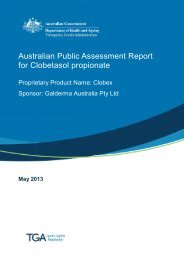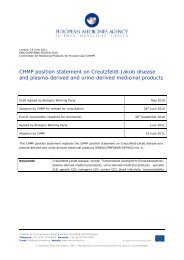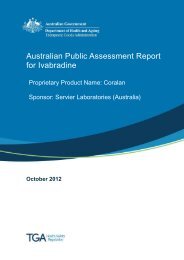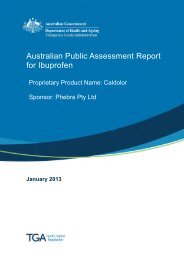AusPAR: Cabazitaxel - Therapeutic Goods Administration
AusPAR: Cabazitaxel - Therapeutic Goods Administration
AusPAR: Cabazitaxel - Therapeutic Goods Administration
You also want an ePaper? Increase the reach of your titles
YUMPU automatically turns print PDFs into web optimized ePapers that Google loves.
<strong>AusPAR</strong> Jevtana <strong>Cabazitaxel</strong> Sanofi-Aventis Australia Pty Ltd PM-2010-02565-3-4<br />
Final 9 February 2012<br />
<strong>Therapeutic</strong> <strong>Goods</strong> <strong>Administration</strong><br />
The elimination profile of cabazitaxel has been shown to be triphasic, with rapid initial<br />
and intermediate phases (half-life [t1/2]: 4.4 minutes [min] and 1.6 h respectively) followed<br />
by a long terminal phase with a half-life of 95.1 h (Study POH 0124).<br />
Renal clearance<br />
Following a 1 h infusion of cabazitaxel, the clearance was a population value of 48.5 L/h<br />
(for a patient with median BSA of 1.84 m 2). This was comparable with the clearance<br />
estimated in patients with advanced solid tumours. However, it was more than twofold<br />
higher than that estimated in patients with metastatic breast cancer in Study ARD 6191.<br />
Pharmacokinetics in other special populations<br />
Pharmacokinetics in subjects with impaired hepatic function<br />
<strong>Cabazitaxel</strong> is mainly metabolized by the liver. However, the limited number of patients<br />
with abnormal liver function prevents any conclusion being reached.<br />
Pharmacokinetics in subjects with impaired renal function<br />
<strong>Cabazitaxel</strong> is minimally excreted via the kidneys. In the population PK analysis, of the 170<br />
patients, 14 patients had moderate renal impairment (creatinine clearance [CLcr] ≥30 to<br />
≤50 mL/min) and 59 had mild renal impairment (CLcr ≥50 to ≤80 mL/min). Mild to<br />
moderate renal impairment appears not to have significant effects on the PK of<br />
cabazitaxel.<br />
Pharmacokinetics according to age<br />
The population PK analysis did not identify age as a significant factor in cabazitaxel PK.<br />
Pharmacokinetics related to genetic factors (sex, ethnicity, genetic polymorphism)<br />
Plasma clearance in studies of patients with advanced solid tumours was the same in both<br />
males and females. In Study TCD 6945, the plasma clearance of cabazitaxel when used in<br />
combination with capecitabine for the treatment of patients with metastatic breast cancer<br />
was similar to that when cabazitaxel was used as monotherapy in patients with advanced<br />
solid tumours. In Study ARD 6191 of cabazitaxel monotherapy in patients with metastatic<br />
breast cancer, the clearance was much lower. The evaluator noted that it is possible that<br />
tumour type rather than gender was the possible cause for the difference. The sponsor<br />
indicated that the lower plasma CL value observed in study ARD6191 is most likely<br />
attributed to a study effect rather than a tumour type effect or gender effect.<br />
Pharmacokinetic interactions<br />
Pharmacokinetic interactions demonstrated in human studies<br />
In Study TCD 6945, cabazitaxel was used in combination with capecitabine in the<br />
treatment of patients with metastatic breast cancer. Capecitabine is converted to 5fluorouracil<br />
(5-FU) in tumours. The PK parameters for capecitabine at dose levels I and III<br />
were (AUC: 6060 - 8870 ng.h/mL) and 5-FU (AUC: 334 - 495 ng.h/mL) and were similar to<br />
that reported in the literature at the same dose. <strong>Cabazitaxel</strong> therefore does not appear to<br />
alter the PK of capecitabine and 5-FU. Similarly capecitabine appears not to alter the PK of<br />
cabazitaxel.<br />
Evaluator’s overall conclusions on pharmacokinetics<br />
<strong>Cabazitaxel</strong> exposure showed dose proportionality over the 10 - 30 mg/m 2 range infused<br />
every 3 weeks. There was no difference in exposure between Cycle 1 and Cycle 2. The<br />
pharmacokinetics of cabazitaxel showed a high clearance, a large volume of distribution at<br />
steady state and a long terminal half-life. It was rapidly metabolised in the liver and<br />
mainly excreted in faeces. Urinary excretion was low. The plasma clearance of cabazitaxel<br />
Page 26 of 75
















